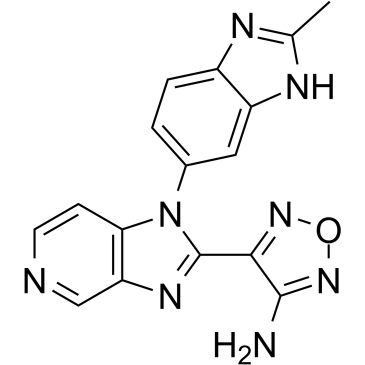2241300-50-3
| Name | AS2863619 free base |
|---|
| Description | AS2863619 free base enables conversion of antigen-specific effector/memory T cells into Foxp3+ regulatory T (Treg) cells for the treatment of various immunological diseases. AS2863619 free base is a potent, orally active cyclin-dependent kinase 8 (CDK8) and CDK19 inhibitor with IC50s of 0.61 nM and 4.28 nM, respectively. STAT5 activation enhanced by AS2863619 free base inhibition of CDK8/19, which consequently activates the Foxp3 gene[1]. |
|---|---|
| Related Catalog | |
| Target |
CDK8:0.61 nM (IC50) CDK19:4.28 nM (IC50) GSK3α:76.67 nM (IC50) GSK3β:63.06 nM (IC50) STAT5 |
| In Vitro | AS2863619 (1 μM; 22 hours; mouse CD4+ T cells) treatment suppresses serine phosphorylation of the PSP motif of STAT5b to ~40% while enhancing tyrosine phosphorylation in the C-terminal domain to ~160% of control-treated samples[1]. Western Blot Analysis[1] Cell Line: Mouse CD4+ T cells Concentration: 1 μM Incubation Time: 22 hours Result: Suppressed serine phosphorylation of the PSP motif of STAT5b to ~40% while enhancing tyrosine phosphorylation in the C-terminal domain to ~160% of control-treated samples. |
| In Vivo | AS2863619 (30 mg/kg; oral administration; daily; for 2 weeks; mice) treatment after sensitization with 2,4-dinitrofluorobenzene (DNFB) dampens the degree of the secondary response, with milder infiltration of inflammatory cells into the skin and decreases ratios of interferon-γ+ (IFN-γ+) cells in a skin contact hypersensitivity model, when compared with vehicle-treated control mice. Treg depletion before the elicitation of the secondary response abolishes AS2863619-induced suppression. KLRG1+ Foxp3+ T cells are specifically increased in DNFB sensitized AS2863619-treated mice[1]. Animal Model: Mice with DNFB-induced contact skin hypersensitivity[1] Dosage: 30 mg/kg Administration: Oral administration; daily; for 2 weeks Result: The degree of the secondary response, with milder infiltration of inflammatory cells into the skin and decreased ratios of interferon-γ+ (IFN-γ+) cells. |
| References |
| Molecular Formula | C16H12N8O |
|---|---|
| Molecular Weight | 332.32 |
